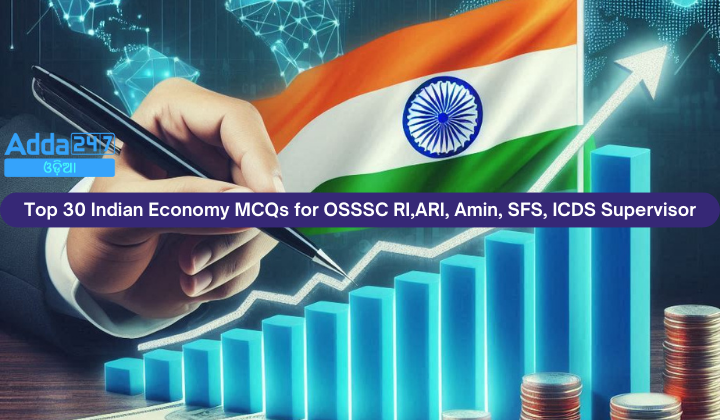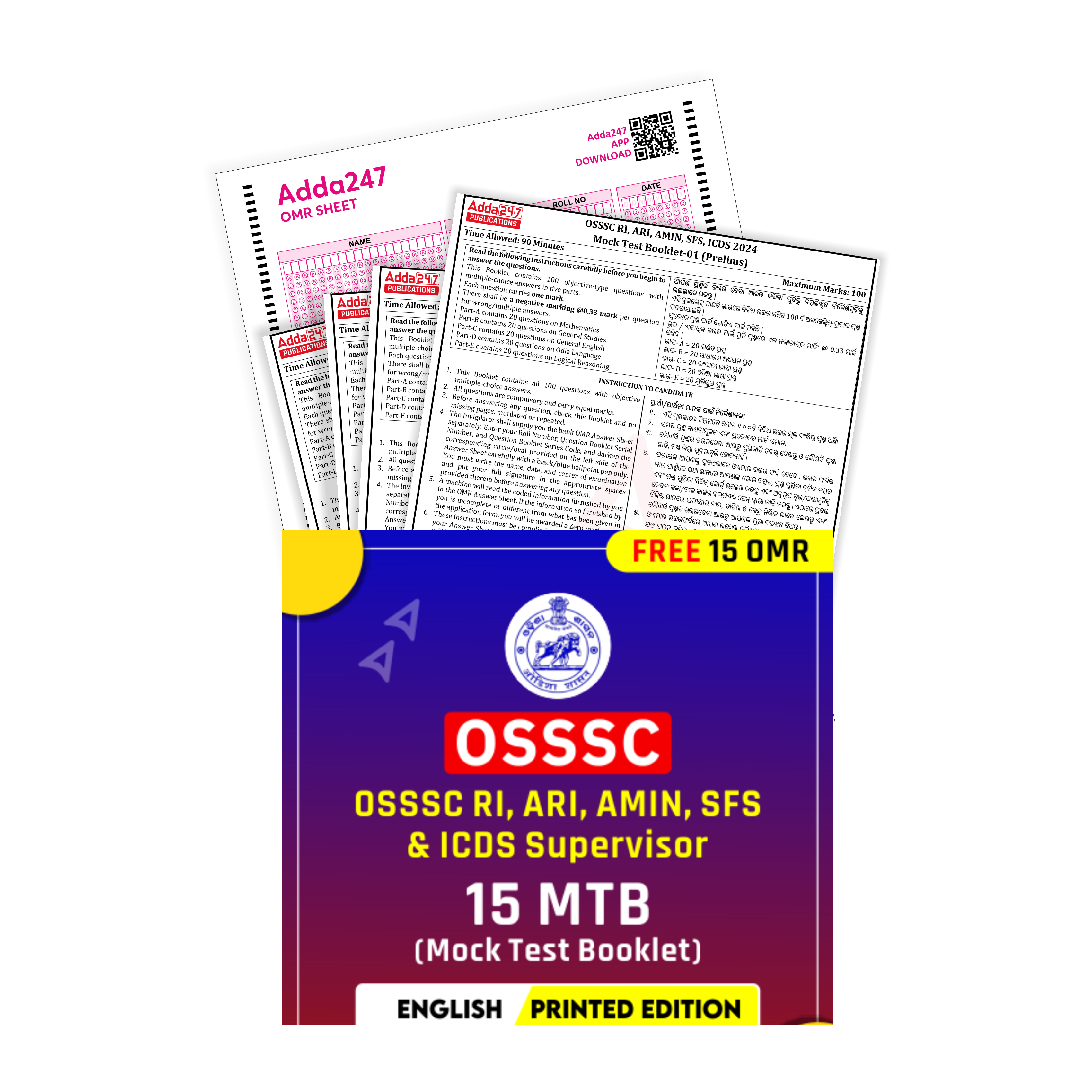Preparing for the OSSSC RI, ARI, Amin, SFS, and ICDS Supervisor exams requires a solid understanding of the Indian economy. These competitive exams often feature questions on economic concepts, policies, and current trends. A focused study of the top 30 multiple-choice questions (MCQs) can significantly enhance your readiness. These questions cover critical topics such as GDP growth, inflation, fiscal policy, banking reforms, and trade. They are tailored to align with the exam pattern, helping candidates gain a comprehensive overview and practice efficiently for their upcoming assessments.
Top 30 Indian Economy MCQs for OSSSC RI,ARI, Amin, SFS, ICDS Supervisor
- What option does the central government not include in the development expenditure?
A) Grants to states
B) Expenditure on social and community services
C) Expenditure on economic services
D) Defence expenditure
Ans. D - Which of the following defines depreciation?
A) Destruction of a plant in a fire accident
B) Loss of equipment over time due to wear and tear
C) Closure of a plant due to labour trouble
D) Closure of a plant due to lockout
Ans. B - Generally, deficit financing can create inflation. However, it can be checked if _________.
A) Government expenditure increases the aggregate supply in the aggregate demand ratio.
B) All the investment is indicated as payment on national debt only.
C) Only the aggregate demand is increased.
D) All of the above
Ans. D - With which of the following did the ARDC merge on 12 July 1982?
A) NABARD
B) EXIM Bank
C) RBI
D) None of the above
Ans. A - What is the main cause of the export surplus?
A) The country’s stringent import policy
B) Developments in national and international markets
C) The country’s exports promotion value
D) None of the above
Ans. B - If RBI reduces the cash reserve ratio, what will happen to the credit creation?
A) There will be no impact.
B) It will decrease.
C) It will increase.
D) None of the above
Ans. C - Which option is not mentioned in a firm’s balance sheet?
A) Cash held at the bank
B) Revenue from sales of the company’s products
C) Total issued capital
D) Value of the stocks of raw materials held
Ans. B - Which of the following does the state financial corporation in the State Bank of India give special assistance to?
A) Medium and small-scale industries
B) Large-scale industries
C) Cottage industry
D) Agricultural farms
Ans. A - Which of the following are the central cooperative banks directly associated with?
A) Central government
B) Land development banks
C) State cooperative banks
D) Farmers
Ans. C - The first complete Indian Bank was established in which year?
A) 1794
B) 1894
C) 1896
D) 1902
Ans. B - Which of the following statements is correct about British rule in India?
(a) The literacy rate was high during the British rule in India
(b) The infant mortality rate was high during the British rule in India
(c) The life expectancy rate was high during the British rule in India
(d) The female literacy rate was high during the British rule in India
Ans. (b) - What was the policy of British rulers in India for industrialisation?
(a) The British rulers wanted to make India an importer of both primary and finished goods
(b) The British rulers wanted to make India an exporter of both primary and finished goods
(c) The British rulers wanted to make India an importer of primary goods from Britain and an exporter of finished goods to Britain
(d) The British rulers wanted to make India an exporter of primary goods to Britain and an importer of finished goods from Britain
Ans. (d) - Which of the following statements is true about the occupational structure of the Indian economy during British rule?
(a) The occupational structure of the Indian economy during the British rule was stagnant
(b) The occupational structure of the Indian economy during the British rule was underdeveloped
(c) The occupational structure of the Indian economy during the British rule was both stagnant and underdeveloped
(d) The occupational structure of the Indian economy during British rule was developed
Ans. (c) - What was one of the major contributions of the Britishers to the Indian economy?
(a) The British rule in India saw the construction of several all-weather roads
(b) The British rule in India saw the introduction of the railway network
(c) The British rule in India saw the development of the inland trade and sea lanes
(d) All of the above
Ans. (b) - Which of the following was the main interest of the zamindar during the British rule in India?
(a) The main interest of the zamindar was to produce cash crops
(b) The main interest of the zamindar was to collect rent from the farmers
(c) The main interest of the zamindar was to improve the condition of the agricultural sector
(d) The main interest of the zamindar was to produce food crops
Ans. (b) - Which of the following statements is true about the industrial sector in the Indian economy during the British rule?
(a) India faced an acute shortage of goods that were made within the country
(b) The growth rate for the industrial sector in India was minimal
(c) India was reduced to being an exporter of raw materials
(d) There was a huge increase in cheap imports of goods in India which were manufactured in Britain
Ans. (a) - Which of the following statements reflects the condition of the agricultural sector in India during British rule?
(a) The agricultural sector experienced huge stagnation and deterioration because of the drain of India’s wealth
(b) The agricultural sector experienced huge stagnation and deterioration because of the land tenure system
(c) The agricultural sector experienced huge stagnation and deterioration because of the decline of handicrafts
(d) None of the above
Ans. (b) - Which of the following was the main reason for decline in the handicrafts sector during the British rule in India?
(a) New patterns of the demand for handicrafts
(b) The tariff policy followed by the British
(c) The competition in the sector due to man-made machines
(d) All of the above
Ans. (d) - Which of the following sectors was the major contributor to the Gross Domestic Product (GDP) during the British rule in India?
(a) Primary sector
(b) Secondary sector
(c) Tertiary sector
(d) None of the above
Ans. (a) - Which of the following statements is an accurate description of the Indian economy on the eve of independence?
(a) India was a net exporter of capital goods
(b) India was a net exporter of primary products
(c) India was a net exporter of industrial products
(d) India was a net exporter of agricultural goods
Ans. (b) - In which year were the details about the population in British India collected for the first time?
(a) 1881
(b) 1891
(c) 1871
(d) None of the above
Ans. (c) - Which of the following industries were operating in the Indian economy on the eve of its independence?
(a) Sugar, paper and cement industries
(b) Iron and steel industries
(c) Jute textile and cotton industries
(d) All of the above
Ans. (d) - Which of the following statements correctly reflects the demographic profile of India on the eve of its independence?
(a) India had an average life expectancy of 63 years
(b) Both the birth rate and death rate in India were very low
(c) The overall levels of literacy in India was even less than 16 percent
(d) The infant mortality rate in India was just around 70 per every thousand live births
Ans. (c) - Which of the following services was totally inadequate during British rule in India?
(a) Law and order, railways and ports
(b) Postal services
(c) Railways and ports
(d) None of the above
Ans. (b) - In which year was India’s first official census survey undertaken?
(a) 1881
(b) 1850
(c) 1891
(d) None of the above
Ans. (a) - Which of the following is the commercial crop in India?
A. Mustard
B. Tobacco
C. Jute
D. All of the above
Ans: D - Which Indian state produces the largest quantity of pulses?
A. Maharashtra
B. Uttar Pradesh
C. Madhya Pradesh
D. Rajasthan
Ans: C - What is the correct descending order of rice-producing states in India?
A. Punjab, West Bengal, Uttar Pradesh, and Andhra Pradesh
B. Punjab, West Bengal, Uttar Pradesh, and Andhra Pradesh
C. Punjab, West Bengal, Uttar Pradesh, and Andhra Pradesh
D. West Bengal, Uttar Pradesh, Punjab, and Andhra Pradesh
Ans: D - What is the correct descending order of food grain-producing states?
A. Uttar Pradesh, Punjab, Madhya Pradesh, and West Bengal
B. Punjab, Uttar Pradesh, Madhya Pradesh, and West Bengal
C. Uttar Pradesh, Punjab, West Bengal, and Madhya Pradesh
D. Uttar Pradesh, Madhya Pradesh, Punjab, and West Bengal
Ans: A - Which of the following is not matched correctly?
A. Rabi Crop………Mustard, Cucumber
B. Rabi Crop………Mustard, Barley
C. Zaid Crop………Moong, vegetables
D. Kharif Crop…..Cotton
Ans: A










